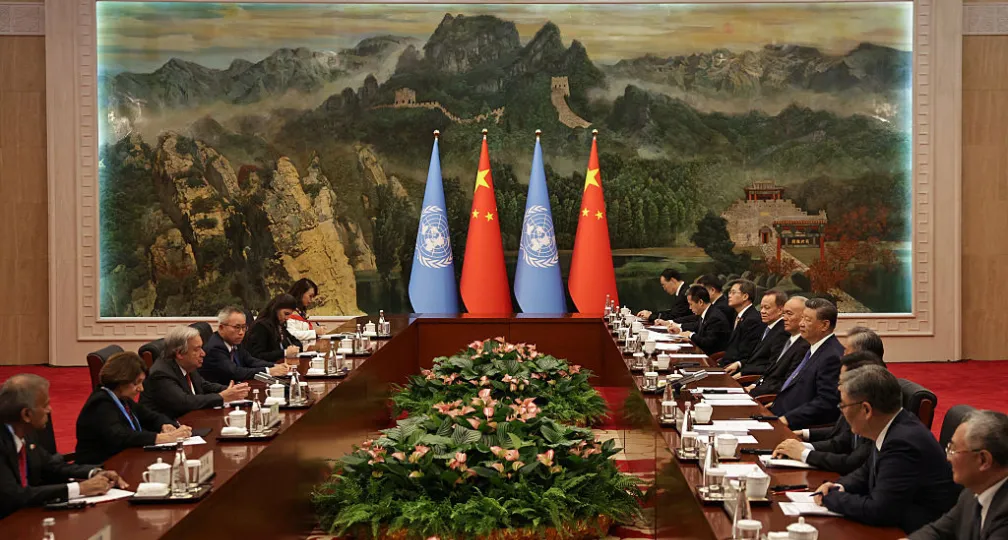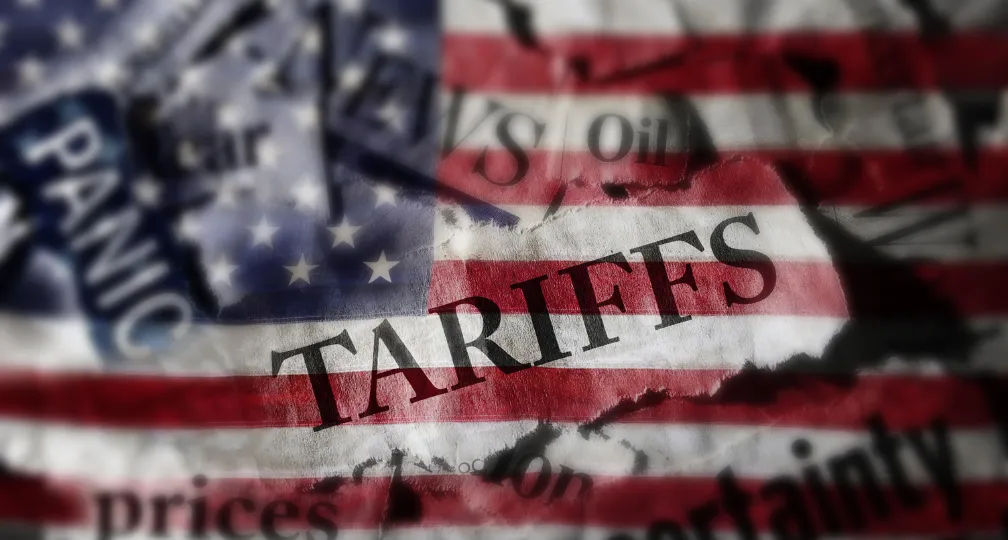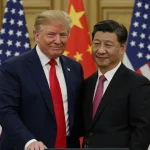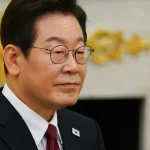After tariffs: Is there a plan to restructure the global economic system?
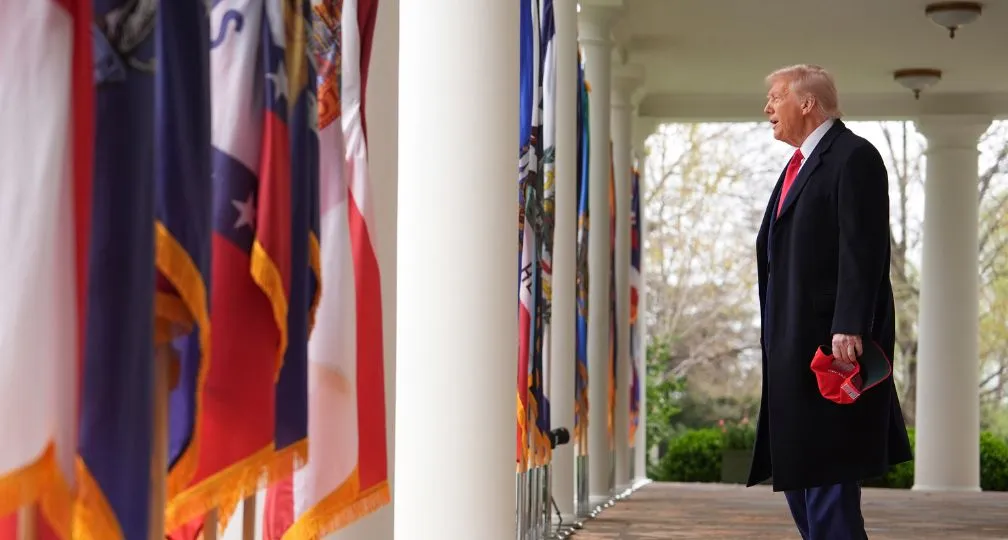
The latest regulatory developments on economic security & geoeconomics
By Paul Nadeau, Visiting Research Fellow, Institute of Geoeconomics (IOG)
Trump Announces Global Tariffs: Donald Trump announced global tariffs on April 2, implementing a baseline 10 percent tariff on all global imports into the United States that go into effect on April 4, along with higher rates on 60 economies he called the “worst offenders” which will go into effect on April 9. The higher rates include 35 percent on China, 20 percent on the European Union, 46 percent on Vietnam, 32 percent on Taiwan, 24 percent on Japan, with Cambodia getting the highest tariff at 49 percent. Goods that are already subject or may be subject to Section 232 tariffs (such as steel & aluminum, autos & auto parts, semiconductors, and others) will not be subjected to the additional tariffs announced today. Trump said that the calculation was made in part by the level of nontariff barriers imposed by other countries. There was no update to the tariffs on Canada and Mexico, which already face a 25 percent tariff dating from March 4, but the April 2 announcement mentioned that if an agreement was reached, tariffs on Canada and Mexico for non-USCMA compliant goods would drop to 12 percent.
The tariffs were imposed under the International Emergency Economic Powers Act (IEEPA), under a new national emergency that was declared on April 2 in response to U.S. trade deficits. The IEEPA which grants the President the power to regulate commerce in response to a national emergency, though this is only the second time that tariffs have been imposed under IEEPA authority, the first time being the tariffs on Canada and Mexico in March. In a separate executive order on April 2, Trump announced that he would close the de minimis loophole with China which allows parcels under a certain value to enter the United States duty-free.
Trump Announces Auto Tariffs: On March 26, the Trump administration announced tariffs of 25 percent on all passenger vehicles (sedans, SUVs, crossovers, minivans, cargo vans) and light trucks, as well as key automobile parts (engines, transmissions, powertrain parts, and electrical components) following a 2019 investigation which found that auto imports impair U.S. national security, though no action was taken at the time of the report. Tariffs on finished autos will be imposed beginning April 3 and tariffs on parts will be imposed no later than May 3. There is a partial exemption from tariffs for vehicles and parts that comply with USMCA rules of origin, but only for the value of their U.S.-produced content.
Trilateral Trade Ministers Meet: On March 30, China, Japan, and South Korea agreed to continue trilateral economic and trade cooperation at the conclusion of the first trilateral trade ministers meeting in five years. They specifically agreed to accelerate negotiations on a trilateral free trade agreement whose talks began in 2012, discussed the recent U.S. tariffs, and pledged to deepen cooperation, including stable supply chains, the digital economy, local-level business and technology exchanges and an effective implementation of the Regional Comprehensive Economic Partnership (RCEP).
OFAC Sanctions Purchasers of Iranian Crude: On March 20, the U.S. Treasury Department’s Office for Foreign Assets Control (OFAC) designated a “teapot” oil refinery and its CEO for purchasing Iranian crude oil, including from vessels linked to Yemen’s Houthi rebels and imposed sanctions on 19 entities and vessels involved in shipping Iranian oil to teapot refineries. The U.S. State Department concurrently sanctioned a China-based entity for having knowingly engaged in a significant transaction to acquire petroleum from Iran.
Trump Tariffs Countries Buying Oil from Venezuela: On March 24, Donald Trump signed an executive order imposing 25 percent tariffs on goods imported into the United States from countries that directly or indirectly import oil from Venezuela. The order was made pursuant to authorities under the International Economic Emergency Powers Act (IEEPA), specifically with respect to the national emergency declared in regards to Venezuela and its Tren de Aragua gang in March 2015 and continued in February 2025.
BIS Expands Entity List: The U.S. Bureau of Industry and Security (BIS) made 80 additions to its Entity List on March 25, including seven firms based in China for quantum computing development, 12 firms for developing technology linked to China’s military end users, several academic and research institutes in China for helping develop advanced technologies with military applications, 27 Chinese firms for the development of hypersonic weapons, a Chinese and an Iranian entity for assisting Iran’s drone development, and 20 entities for their contributions to Pakistan’s nuclear and missile programs. Placement on the Entity List restricts entities from receiving certain U.S.-origin goods, services, and technologies without a license.
Iranian Officials Sanctioned for Disappearance of FBI Agent: On March 25, the U.S. Treasury Department, in coordination with the Federal Bureau of Investigation, imposed sanctions on three Iranian Ministry of Intelligence and Security officials that were involved in the abduction, detention, and probable death of a former FBI special agent Robert Levinson who went missing in 2007 and was declared dead in 2020.
Postponement in Nippon Steel Lawsuit: The U.S. Justice Department asked to postpone oral arguments in Nippon Steel’s suit of the Biden administration’s decision to block its acquisition of U.S. Steel. The request was apparently made to give the U.S. government more time to negotiate on a settlement with Nippon Steel, which agreed to the request to postpone oral arguments until the week of May 12.
USTR Named Head of Independent Watchdog Agencies: U.S. Trade Representative Jamison Greer was named acting head of the Office of Special Counsel and Office of Government Ethics, the independent U.S. government agencies that handle whistleblower complaints and ethics oversight. The appointment of a member of the Trump administration to two agencies responsible for government oversight have raised questions about the agencies’ independence in the Trump administration.
After tariffs: Is there a plan to restructure the global economic system?
By Andrew Capistrano, Visiting Research Fellow, Institute of Geoeconomics (IOG)
In the lead-up to “Liberation Day” on 2 April, many reports suggested that the Trump administration was still engaged in internal debates over how to impose reciprocal tariffs on US trading partners right up until the day they were announced. This apparent indecisiveness raises doubts about whether Trump has fully considered the complex challenge of restructuring the global trading system he is now disrupting. However, since some of his advisors have hinted that tariffs are merely the first step in a broader strategy to address persistent US trade deficits, it is worth examining what might come next.
With trade policy dominating discussions it is easy to overlook the broader context of US trade imbalances. Importantly, the US trade deficit is closely linked to the strength of the dollar, which remains high due to global demand for it as a “safe” reserve asset and a facilitator of international transactions. This persistent demand for dollars, reinforced by its status as the world’s reserve currency, also drives inelastic demand for US Treasuries. As a result, the dollar has appreciated against other currencies to its highest inflation-adjusted level in 40 years, which overwhelms any downward pressure that should come from the US trade deficit. And since tariffs often strengthen the dollar—because other countries may devalue their currencies to maintain US market share—trade policy alone cannot achieve Trump’s goals of boosting US manufacturing, making exports more competitive, or rebuilding the domestic industrial base without a parallel strategy to address dollar overvaluation.
Trump thinks tariffs create bargaining leverage. Now that tariffs have been imposed, it is reasonable to expect that there will be some push to use this leverage to not only reduce tariffs among US trading partners, but also weaken the dollar.
One interesting proposal is to offer tariff reductions to countries that acquiesce to Trump’s demand for “reciprocity”, and to allow preferential dollar access to those that enter into a “Mar-A-Lago Accord” on exchange rates. This idea began to gain traction after economist Stephen Miran became Trump’s Chair of the Council of Economic Advisers in early March. Right after Trump was elected, Miran put out a paper entitled “A User’s Guide to Restructuring the Global Trading System”, which outlined a sequence of steps to revalue the dollar—while simultaneously retaining its reserve currency status and not driving up US borrowing costs. Although Miran’s ideas have been criticized as unworkable or fraught with contradictions they do possess a certain internal logic, and crucially, they may also possess an essential feature for any policy proposal today: an ability to appeal to Trump’s unorthodox economic views.
In Miran’s sequence, after tariffs the next step is to make the linkage between US trade and security policy explicit. This may offer an additional rationale beyond revenues or reciprocity to explain Trump’s tariffs on allies, since the Miran strategy argues US defense commitments, market access, and the provision of the dollar for third-party transactions should be seen as intertwined benefits. Allies and partners that want to continue to receive these benefits should therefore be incentivized to help the US sustainably supply them.
Essentially, the US would provide security, and in exchange, allies would help restore US manufacturing by investing in the US or appreciating their currencies against the dollar. As Treasury Secretary Scott Bessent has suggested, the US could have a “traffic light” system that divides the world into three tiers: “green” countries with shared values, aligned economic and security goals, and a willingness to cooperate on exchange rates; “yellow” or neutral countries that want to keep high tariffs and remain outside the US defense system; and “red” countries, meaning adversaries or sanctioned nations that refuse to cooperate. More concretely, this means countries that lower their tariffs on US goods (or opt to not retaliate against US “reciprocal” tariffs), reduce their subsidies, or offer the US economic collateral like critical mineral rights will have preferential access to the US market and defense umbrella. In other words, Miran implies that there would be economic barriers to entry for continued US security guarantees, but that these would become more credible due to the economic linkages.
Once the US has identified its “friends” and “foes”, Miran believes there would be space to revalue the dollar. Within the “green” bloc, presumably including key partners in Europe, East Asia, the Middle East, and Latin America, there are several ways that coordinated central bank intervention could facilitate dollar depreciation. The US could reduce tariffs if these partners agree to sell short-term US Treasuries from their reserves in exchange for their own currencies. To offset the higher bond yields that would likely be triggered by this move, these partners would also agree to swap their existing short-term Treasuries into smaller dollar amounts of “century bonds”—bonds with 100-year maturities and near-zero interest rates. Combined, Miran projects that this would depreciate the dollar relative to other currencies in the “green” bloc, reduce the fiscal pressure from ballooning interest on US debt, and keep the dollar’s share of global central bank reserves stable. Bessent, after all, has claimed that dollar depreciation and dollar dominance are not mutually exclusive.
It goes without saying that this part of the plan would be difficult to execute, not least because of the pushback from central bankers in partner countries. Anticipating the infeasibility of revaluing the dollar multilaterally—a replay of the 1985 “Plaza Accord”—Miran offers several options for unilateral action as well. Some are quite interesting as they dovetail with actions Trump has already taken, such as the creation of a US sovereign wealth fund (SWF). An SWF could use US assets, like gold reserves or federally owned land, to collateralize debt sold to partner countries. It could also deploy these assets to accumulate other currencies and intervene in foreign exchange markets to add downward pressure on the dollar. Other unilateral options include taxing capital inflows, as the America First Investment Policy executive order initiated a review of a 1984 treaty that removed a 30 percent tax on Chinese capital. Another is to use the International Emergency Economic Powers Act (IEEPA), the authority Trump used to tariff Canada and Mexico, to impose “user fees” on foreign reserve holdings of dollar-denominated assets like US Treasuries, which could reduce demand.
Tariffs play a pivotal role in this scheme, as they provide the “stick” to complement the “carrot” of US defense commitments and market access that would bring allied nations to the bargaining table. But Miran also claims that the US alliance system cannot persist given the problem of dollar overvaluation. In his view, the growth of the global economy makes it “increasingly burdensome” for the US to finance both the provision of dollar reserves and security commitments to its allies. Too many dollars are held in foreign reserves, negatively influencing exchange rates and reducing reciprocal trade flows. Because the US pays interest on foreign holdings of Treasuries, these bonds can collect rents rather than being utilized to enhance trade; charging “user fees” would discourage hoarding, putting dollars to work in a way that encourages trade reciprocity. At the same time, now that the annual interest payments on US debt have surpassed defense spending, relieving the burden of these immobile foreign reserves could conceivably free up the fiscal space for increased global security provisions.
The question is whether the US “currency zone” can be realigned to fit its “security zone” without accelerating the trend toward de-dollarization. Since the current trading and financial system was designed for a different geopolitical environment, one could argue that heightened US-China competition necessitates a rethink of these structures. But the global financial system is already beginning to fracture along geopolitical lines, a trend that gained traction after the Biden administration “weaponized” the dollar to freeze Russia’s US bond holdings following its February 2022 invasion of Ukraine. By 2024, there was talk among the G7 to actually seize these assets to help fund Ukraine’s defense. This had the unforeseen effect of incentivizing a parallel BRICS/SCO currency order, and while it remains in its early stages, China clearly intends to promote its CIPS alternative to SWIFT and renminbi swap lines for its partners, all backstopped by increased gold holdings. And on 17 March, the PBOC announced that a digital renminbi settlement system would connect to ten ASEAN currencies and six Middle Eastern currencies. Obviously, neither Trump nor his advisors want to inadvertently advance this process further.
Similarly, attempting to force allies into a grand currency deal—one that gives the US immediate benefits in exchange for future security commitments—has its own risks. The EU is already aiming to increase defense spending and is looking to offset its dependence on the US in the wake of Trump’s rapprochement toward Putin, and the prospect of a trade war has made the US market considerably less attractive in the short term. Adding dollar coercion to the mix could revitalize the 2000s-era dream of promoting the euro as an alternative global reserve currency.
Miran reasons that the Eurozone is too fragmented and China’s renminbi lacks the convertibility necessary to be credible alternative reserve currencies; in fact, he thinks that if this were not the case, the problem of dollar overvaluation would not be as intractable. But a lack of alternatives is not a good foundation on which to restructure the global financial system. Trust would be better, although paradoxically this is being undermined by the uncertainty surrounding Trump’s tariff policies.
A final issue for US allies and partners is that in the era of geoeconomics, it may be inevitable that the dollar becomes more aligned with US security objectives. Nations that want to maintain “free” dollar access and preserve monetary policy flexibility run the risk of being forced to side with the US in its economic competition against China. This is because neutral (“yellow”) states may have to choose between using the dollar at a fixed exchange rate accepted by the US, or else paying a premium to access dollar swap lines in a financial crisis or even for the privilege of using the reserve currency in third-party transactions. The alternative would be to fully align with the nascent BRICS/SCO system, which at present has significant downsides.
More immediately, it is clear that the Trump administration is using tariffs as a pressure tool. Whether this will lead to grand deals or global downturns remains to be seen. But with the US leveraging its economic power to disrupt the trading system, it can no longer be discounted that it might leverage its financial and military power to restructure this system in a way that reinforces its industrial and geopolitical priorities. Regardless, now that “Liberation Day” is here, the world awaits the next move in Trump’s plan—if he has decided on one.
(Photo Credit: AP/Aflo)
Disclaimer: The views expressed in this IOG Economic Intelligence Report do not necessarily reflect those of the API, the Institute of Geoeconomics (IOG) or any other organizations to which the author belongs.
API/IOG English Newsletter
Edited by Paul Nadeau, the newsletter will monthly keep up to date on geoeconomic agenda, IOG Intelligencce report, geoeconomics briefings, IOG geoeconomic insights, new publications, events, research activities, media coverage, and more.



Visiting Research Fellow
Andrew Capistrano is Director of Research at PTB Global Advisors, a Washington DC-based geopolitical risk consulting firm. Specializing in economic competition between the US/EU and China, he analyzes how trade, national security, and industrial policies impact markets, and his firm’s clients include Japanese corporations and government agencies. He previously worked in Tokyo at the US Embassy’s American Center Japan and as a research associate at the Rebuild Japan Initiative Foundation / Asia-Pacific Initiative. Dr Capistrano holds a BA from the University of California, Berkeley; an MA in political science (international relations and political economy) from Waseda University; and a PhD in international history from the London School of Economics. His academic work focuses on the diplomatic history of East Asia from the mid-19th to the mid-20th centuries, applying game-theoretic concepts to show how China's economic treaties with the foreign powers created unique bargaining dynamics and cooperation problems. During his doctoral studies he was a research student affiliate at the Suntory and Toyota International Centres for Economics and Related Disciplines (STICERD) in London.
View Profile
Visiting Research Fellow
Paul Nadeau is an adjunct assistant professor at Temple University's Japan campus, co-founder & editor of Tokyo Review, and an adjunct fellow with the Scholl Chair in International Business at the Center for Strategic and International Studies (CSIS). He was previously a private secretary with the Japanese Diet and as a member of the foreign affairs and trade staff of Senator Olympia Snowe. He holds a B.A. from the George Washington University, an M.A. in law and diplomacy from the Fletcher School at Tufts University, and a PhD from the University of Tokyo's Graduate School of Public Policy. His research focuses on the intersection of domestic and international politics, with specific focuses on political partisanship and international trade policy. His commentary has appeared on BBC News, New York Times, Nikkei Asian Review, Japan Times, and more.
View Profile-
 Japan-India Defense in a Fragmenting Indo-Pacific2025.12.10
Japan-India Defense in a Fragmenting Indo-Pacific2025.12.10 -
 The “Economic Security is National Security” Strategy2025.12.09
The “Economic Security is National Security” Strategy2025.12.09 -
 India - Japan: The Glimpse of a Shared Vision2025.12.05
India - Japan: The Glimpse of a Shared Vision2025.12.05 -
 Beijing’s ‘Globalist’ Agenda Under Trump 2.02025.12.01
Beijing’s ‘Globalist’ Agenda Under Trump 2.02025.12.01 -
 Trump’s Tariffs Might Be Here to Stay – No Matter Who’s in Power2025.11.28
Trump’s Tariffs Might Be Here to Stay – No Matter Who’s in Power2025.11.28
 Event Report: The Trump Tariffs and Their Impact on the Japanese Economy2025.11.25
Event Report: The Trump Tariffs and Their Impact on the Japanese Economy2025.11.25 The Real Significance of Trump’s Asia Trip2025.11.14
The Real Significance of Trump’s Asia Trip2025.11.14 The “Economic Security is National Security” Strategy2025.12.09
The “Economic Security is National Security” Strategy2025.12.09 The long road to a South Korea-U.S. trade deal2025.11.26
The long road to a South Korea-U.S. trade deal2025.11.26 India’s Structural Reforms: Opportunities and Risks2025.11.14
India’s Structural Reforms: Opportunities and Risks2025.11.14





